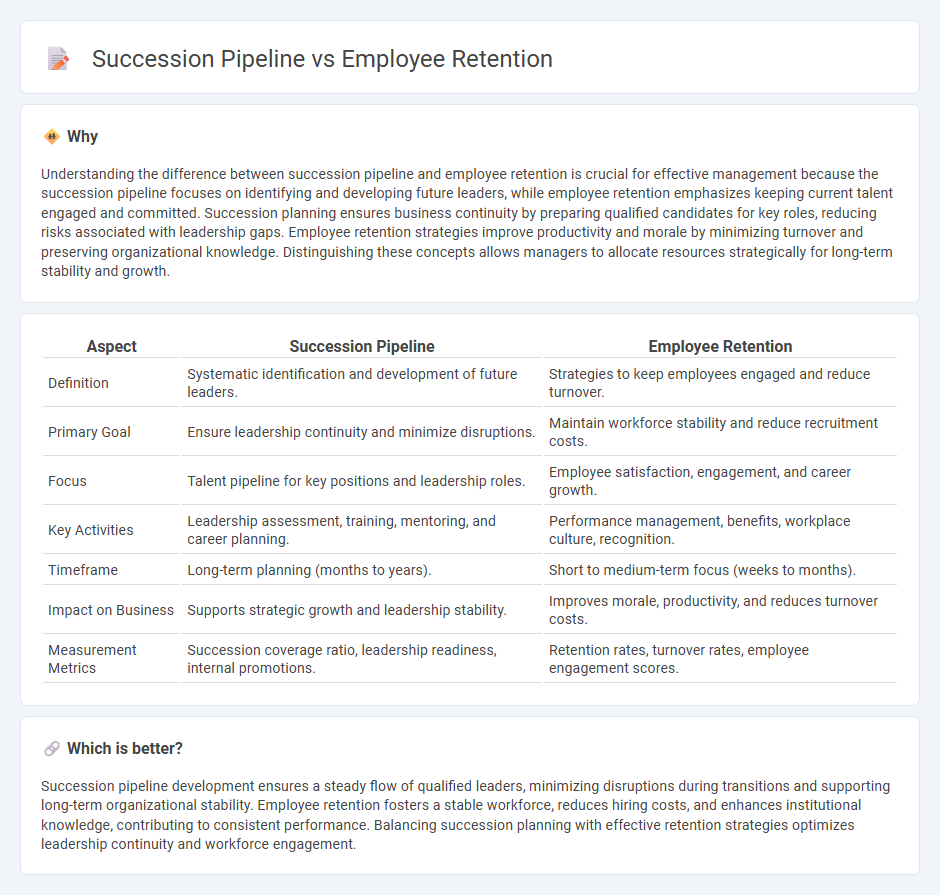
Effective management strategies balance the development of a robust succession pipeline with employee retention initiatives to ensure organizational stability and growth. Succession planning identifies and prepares future leaders, while retention efforts focus on maintaining a motivated and skilled workforce. Explore how integrating these approaches optimizes talent continuity and drives long-term success.
Why it is important
Understanding the difference between succession pipeline and employee retention is crucial for effective management because the succession pipeline focuses on identifying and developing future leaders, while employee retention emphasizes keeping current talent engaged and committed. Succession planning ensures business continuity by preparing qualified candidates for key roles, reducing risks associated with leadership gaps. Employee retention strategies improve productivity and morale by minimizing turnover and preserving organizational knowledge. Distinguishing these concepts allows managers to allocate resources strategically for long-term stability and growth.
Comparison Table
| Aspect | Succession Pipeline | Employee Retention |
|---|---|---|
| Definition | Systematic identification and development of future leaders. | Strategies to keep employees engaged and reduce turnover. |
| Primary Goal | Ensure leadership continuity and minimize disruptions. | Maintain workforce stability and reduce recruitment costs. |
| Focus | Talent pipeline for key positions and leadership roles. | Employee satisfaction, engagement, and career growth. |
| Key Activities | Leadership assessment, training, mentoring, and career planning. | Performance management, benefits, workplace culture, recognition. |
| Timeframe | Long-term planning (months to years). | Short to medium-term focus (weeks to months). |
| Impact on Business | Supports strategic growth and leadership stability. | Improves morale, productivity, and reduces turnover costs. |
| Measurement Metrics | Succession coverage ratio, leadership readiness, internal promotions. | Retention rates, turnover rates, employee engagement scores. |
Which is better?
Succession pipeline development ensures a steady flow of qualified leaders, minimizing disruptions during transitions and supporting long-term organizational stability. Employee retention fosters a stable workforce, reduces hiring costs, and enhances institutional knowledge, contributing to consistent performance. Balancing succession planning with effective retention strategies optimizes leadership continuity and workforce engagement.
Connection
A strong succession pipeline directly influences employee retention by providing clear career advancement opportunities and demonstrating organizational commitment to professional growth. Companies with well-defined succession plans reduce turnover rates as employees feel valued and motivated to stay. Retention strategies that integrate succession planning enhance talent continuity and preserve institutional knowledge.
Key Terms
Turnover Rate
Employee retention strategies directly impact turnover rate by reducing the frequency at which employees leave the organization, stabilizing workforce continuity. Succession pipeline development prepares internal candidates for key roles, minimizing disruptions caused by turnover and ensuring leadership readiness. Discover effective methods to balance retention and succession planning for optimal workforce management.
Leadership Development
Employee retention strategies emphasize maintaining talent by fostering leadership development programs that enhance skills and job satisfaction. Succession pipelines prioritize identifying and preparing high-potential leaders to ensure organizational continuity and future-ready leadership. Explore effective leadership development techniques to optimize both retention and succession planning outcomes.
Talent Mapping
Employee retention focuses on maintaining a stable workforce by identifying high-potential employees and fostering their engagement, while succession pipeline development aims to prepare these individuals for future leadership roles through targeted talent mapping. Talent mapping plays a critical role by analyzing workforce skills, career aspirations, and performance metrics to align employee growth with organizational needs. Explore how integrating talent mapping strategies can optimize both retention and succession planning for sustainable business success.
Source and External Links
Employee retention - Wikipedia - Employee retention is the ability of an organization to retain its employees and ensure sustainability, achieved through best practices such as realistic recruitment previews, socialization programs, and continuous training and development opportunities.
Employee retention: The real cost of losing an employee - Proven retention strategies include hiring the right employees, maintaining clear goals, optimizing onboarding, offering career advancement, fostering a positive culture, recognizing employees, and maintaining open communication to reduce costly turnover.
What is Employee Retention? | Definition from TechTarget - Employee retention is the organizational goal of keeping productive workers and reducing turnover by fostering a positive work atmosphere, competitive pay, benefits, work-life balance, and offering flexible work arrangements.
 dowidth.com
dowidth.com